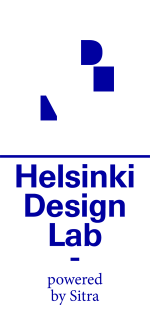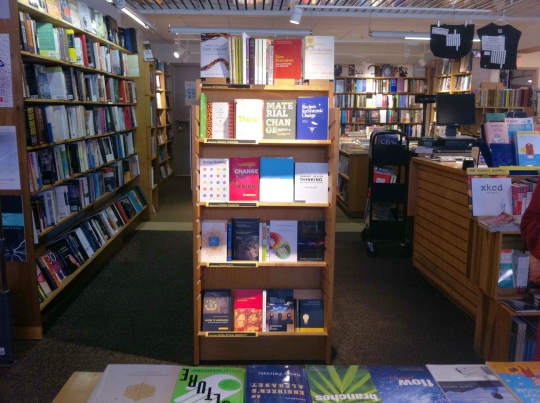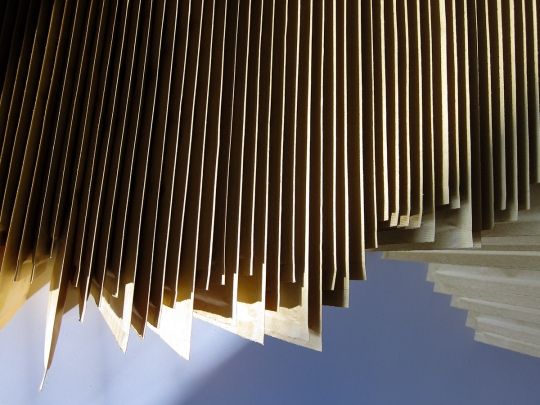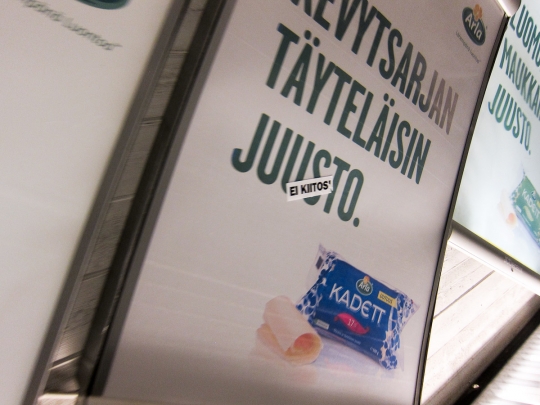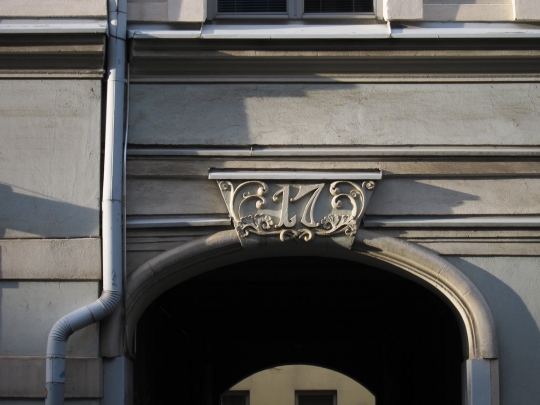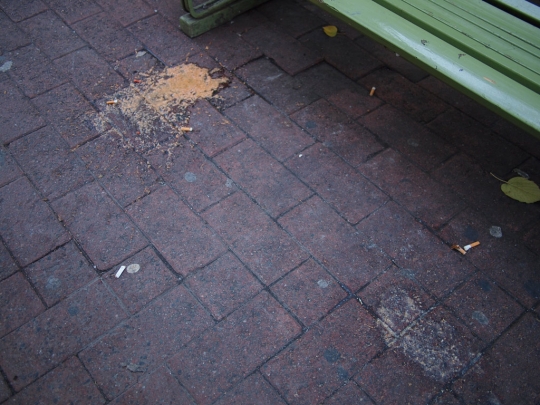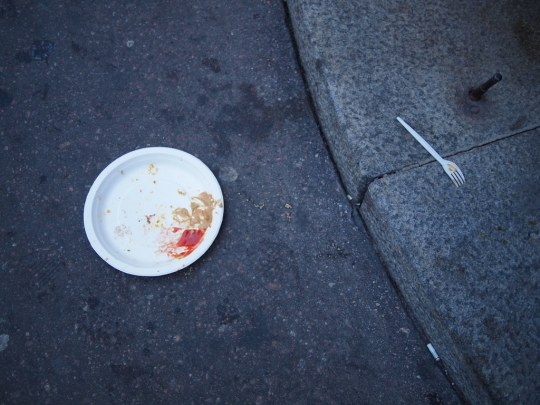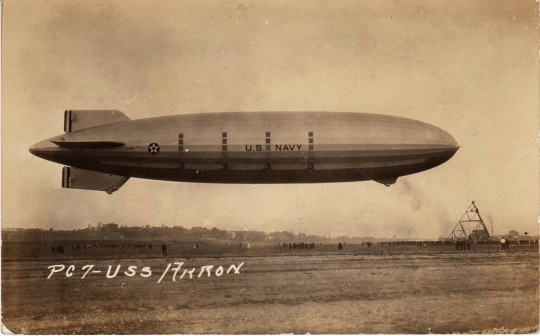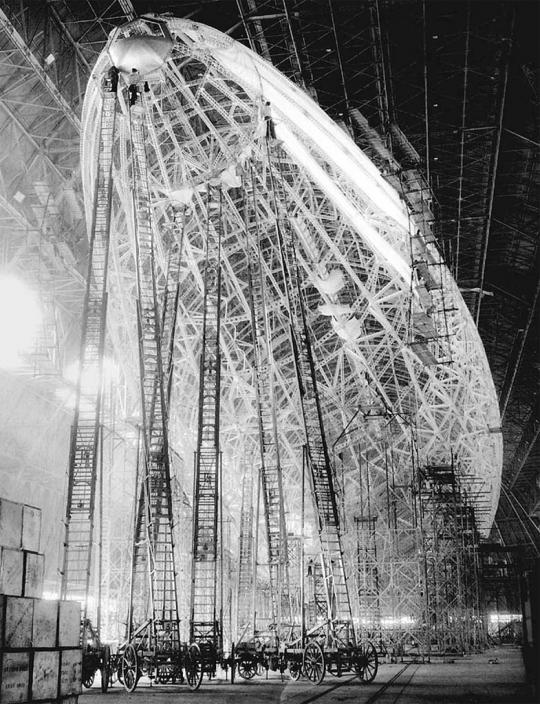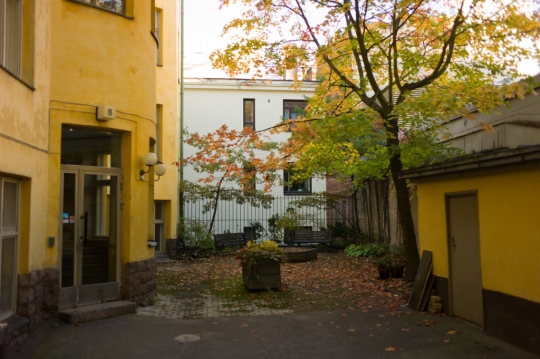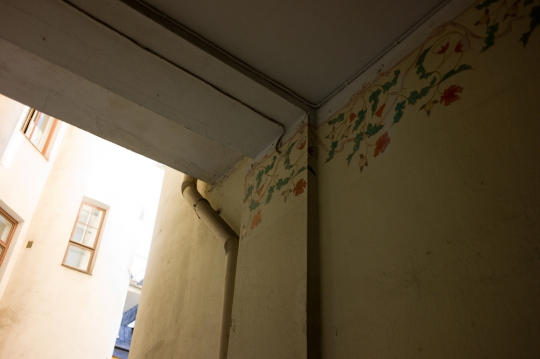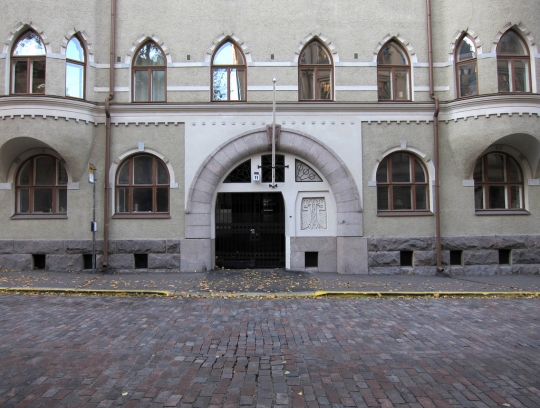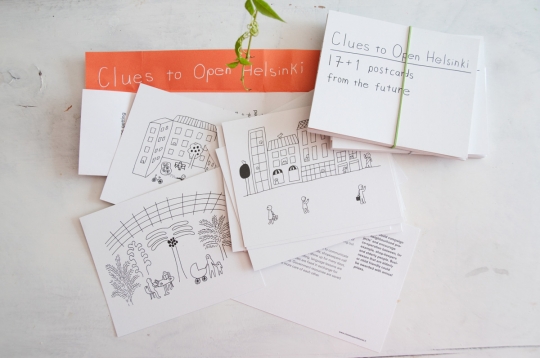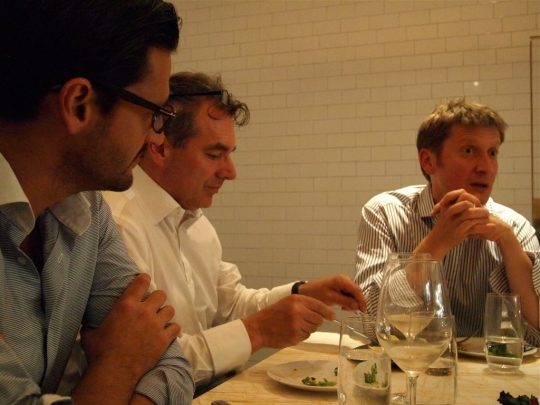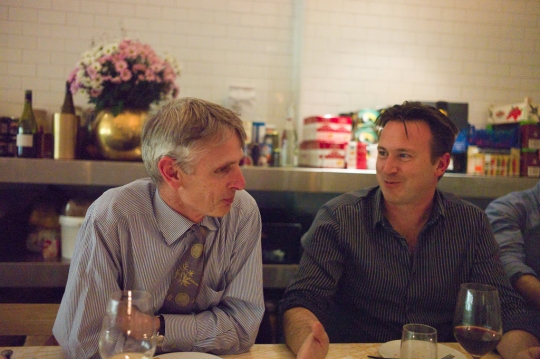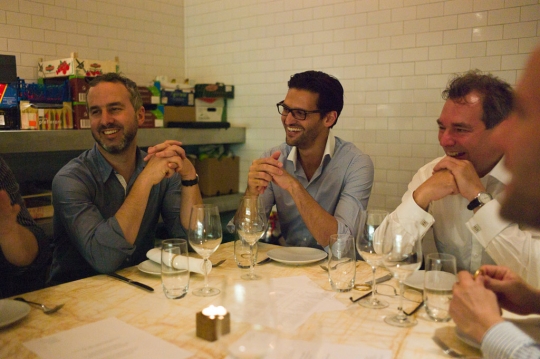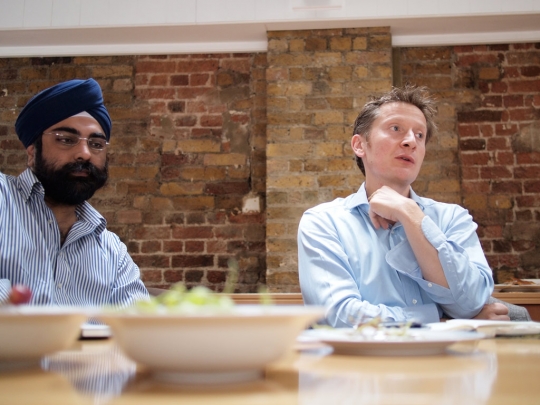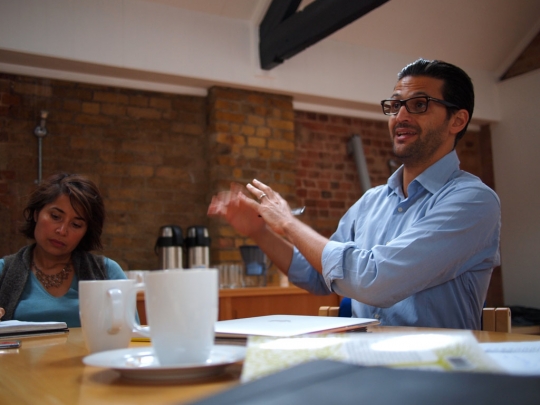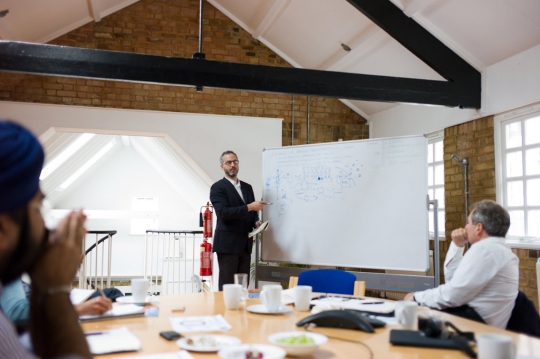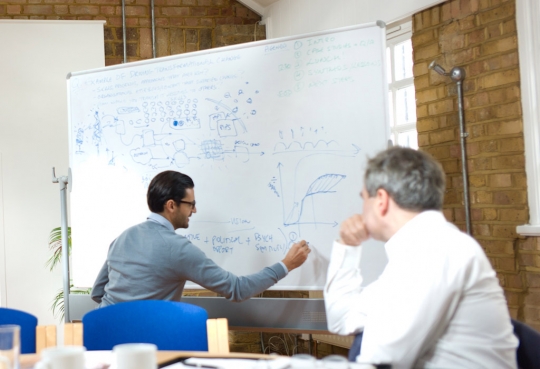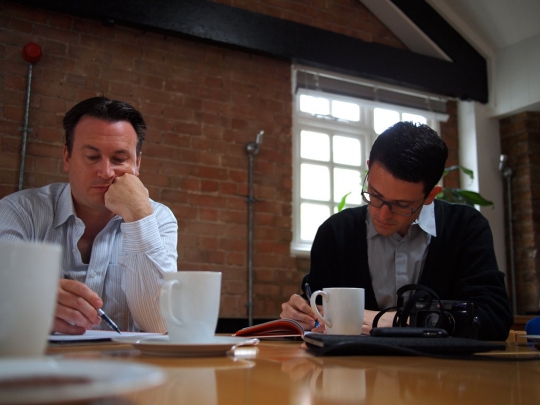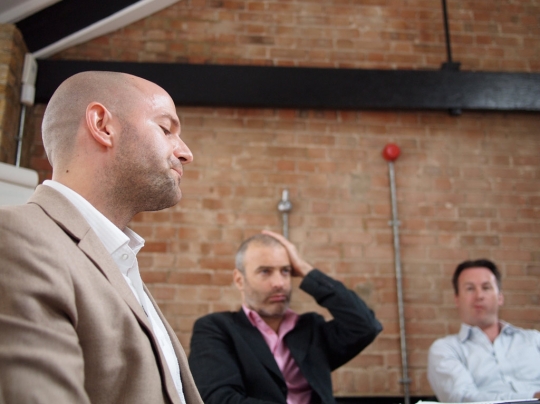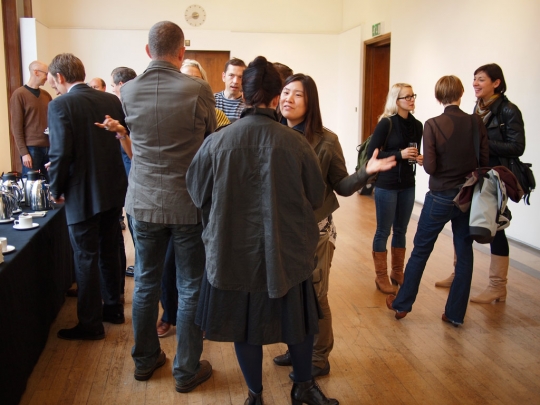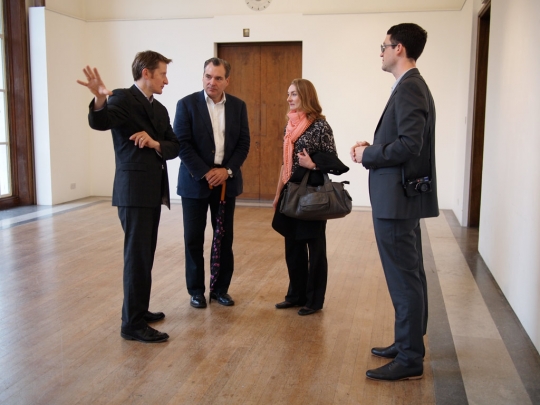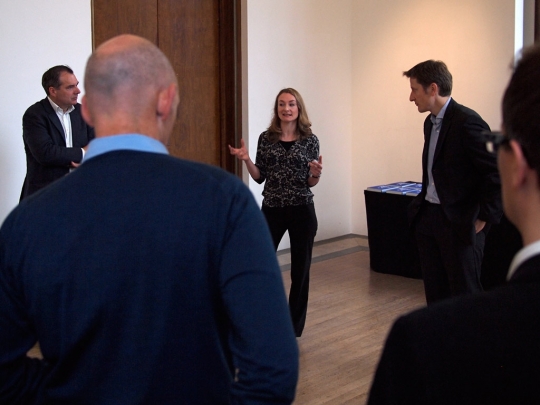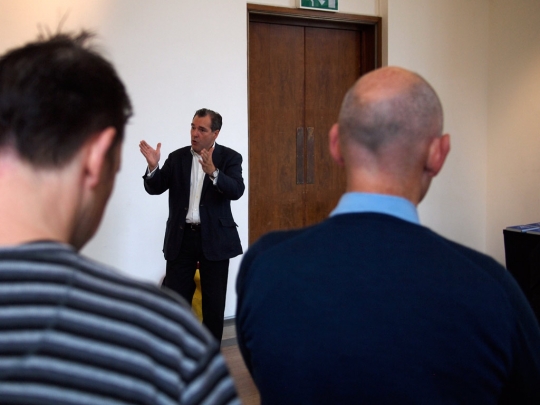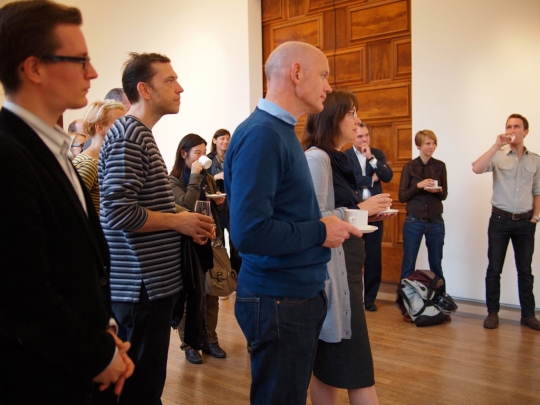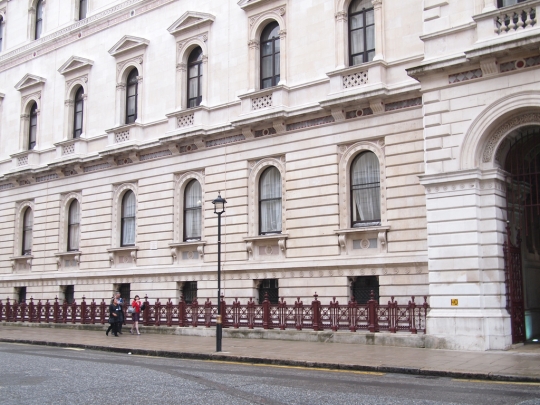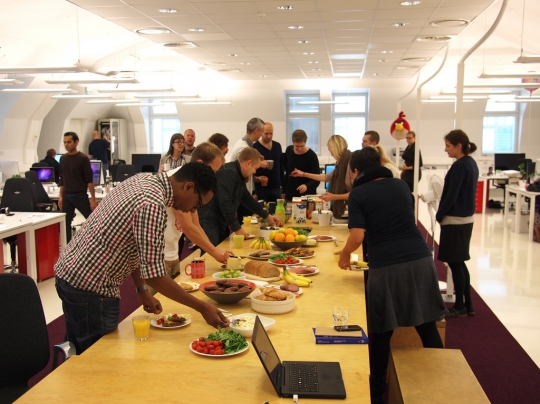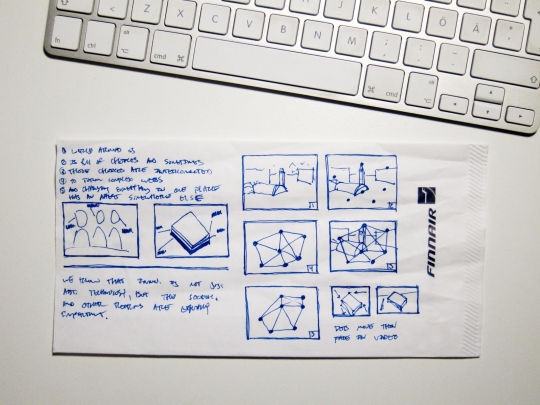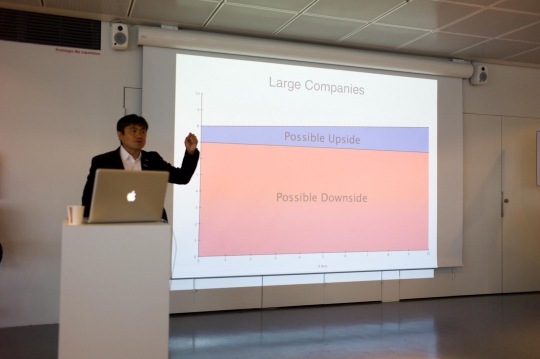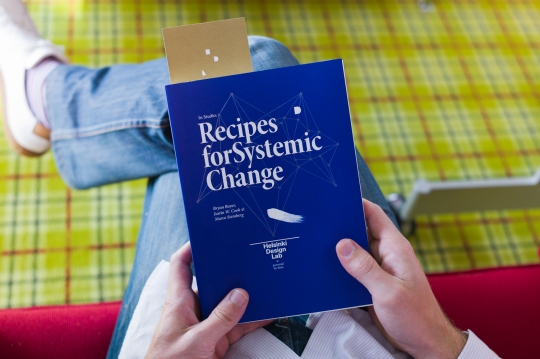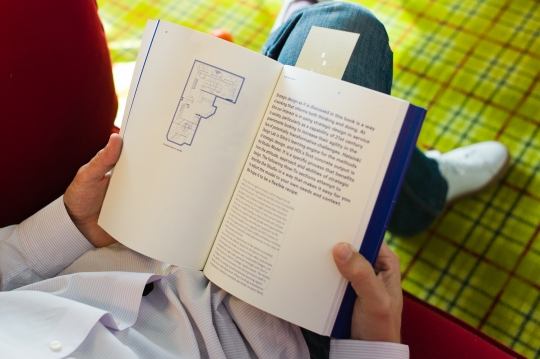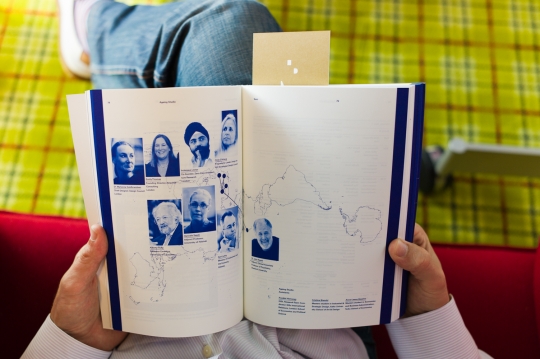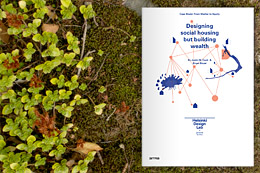Weeknotes
Roll call! Johanna is mostly pitching in on Synergize Finland projects, Justin is holding down the fort in Boston, Marco is in Moscow giving a talk at Skolkovo, and Dan is somewhere in Australia running at a breakneck pace with a full slate of talks, workshops, and meetings there. For more on that, follow Dan's Twitter account or look for the mentions of @HDL2010. And this leaves me, alone in Helsinki, spending the day out and about and writing.
Between bouts of project planning and other exciting administrative duties we've been continuing to drive our research into the street food of Helsinki. Below is a snippet of that, one of four narratives that we open the booklet with. They're meant to give snapshots of different key moments in the development of Helsinki's food culture. As you might guess, we're much more interested in the stuff around the food than the victuals themselves.
Ullanlinna, 1960
The woman shifts nervously from foot to foot outside the restaurant’s doorway. Above her, a green neon sign sputters into life, casting the restaurant’s name in flowing script across the elegant square, although the sun seems to have no intention of disappearing anytime soon. Still, it was late, and he was late.
She dares not go into the restaurant without him. This is not simply a matter of etiquette, or timidity on her part; it’s the law. In Finland, women are not allowed in restaurants unless accompanied by a man, so she waits. She finds this faintly offensive, as she’s heard that the reasoning is that women in a restaurant or bar on their own could only be there for one thing, and it wasn’t the food.
Dancing isn’t allowed either, for similar reasons; this she finds more ridiculous than offensive. There had been some progress, however: after the Helsinki Olympics, Alko, who set such rules, had deigned to allow the introduction of something equally licentious: the bar stool.
That the new owner of the restaurant is a woman, Mrs. Paukka, is an irony also not lost on her, but it makes no difference. For all her progressive attitudes, the woman had never been to a restaurant before, just as no-one in her family had. But she’d heard about Mrs. Paukka’s new menu—in particular the crispy fried Baltic herrings—and had pestered the man about going for weeks.
The sharp new kiosk across the square, owned by the restaurant and the only one in the country with an alcohol license, is full of men sitting, smoking, drinking, eating gelato, workers from banks and docks alike gathered around the small tables under the trees. She feels their eyes occasionally upon her. The woman pulls a copy of Kaunis Koti from her bag. She’d just bought the magazine from the R-Kioski on Korkeavuorenkatu, and had intended to save it for the tram ride home, but it would prove more useful as a screen to hide behind for the moment.
A skid of leather shoes on the cobbles behind her, accompanied by “Anteeksi, olen myöhässä!” …
Simultaneous to the writing, we're also doing some light data mining. I spent part of yesterday doing a bit of very light scripting to help us more easily pull data from the local restaurant website, Eat.fi. That process looks like this:

Left to right: 1) a map of open restaurants at a particular time, as provided by Eat.fi 2) the code on Eat.fi that makes this view possible 3) a small script that takes a bunch of copy/pasted HTML code and returns a count of the open restaurants 3) collecting that data by hand in Excel 4) visualizing it in Illustrator using a polar graph. Much faster than counting all of the dots on the map 24 times.
We wanted to make a simple point: at the moment when drinking activity on the typical weekend is spiking, food availability is crashing. Restaurants stop serving food and there is very little of a night time economy to speak of. So we made a diagram showing the opening hours of all 569 restaurants in central Helsinki. That's the red line of this diagram:

Red: # of open restaurants at each hour, as detailed in the records of Eat.fi (peaks at 422). Blue: anecdotal observation of public drunkeness (intensity & volume) on a typical Helsinki Friday
The blue line is interpretive, a sketch. It's not based on data at all. As we evolve this diagram we'll figure out a way to handle the discrepancy between these two (one based on data and one anecdotal observation) but for now it's shaping up as a way to illustrate the point. The fact that the red hoop and the blue hoop scarcely overlap is one (small) part of the reason why saturday morning the streets are dotted with puddled of vomit and why alcohol related injuries and assaults are high.
Of course this has a direct impact on the individuals whose health is impacted or who are the victims of violence or property damage. It also indirectly effects the efficacy of Helsinki's tourism strategy that seeks to make this a globally competitive destination. So here too the details matter.
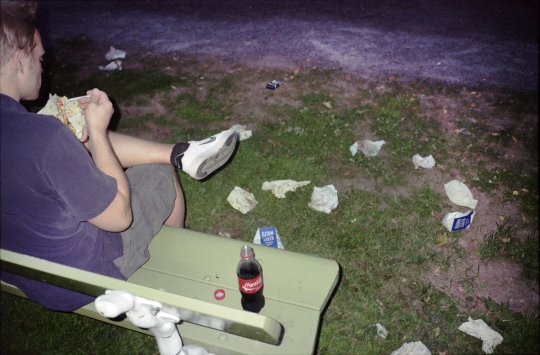
The primary offering today in Helsinki street food. Photo: Kaarle Hurtig for Sitra
As you can see, to make at point that sits at the intersection of governance, business, and culture we're starting to pull together a range of different sources as well. Mixing ephemeral narratives with the historical development of the market and its regulation from 1900 onwards; bits of data with rich imagery; interviews with close observations.
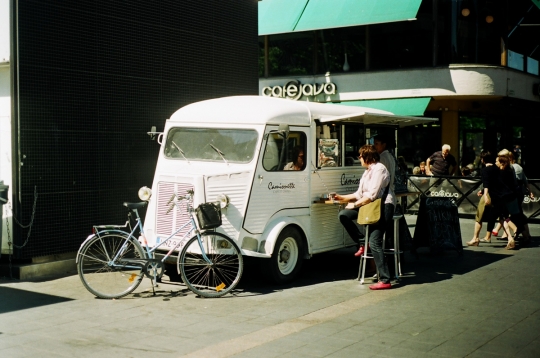
Mid afternoon coffee at Camionette
We've been moving between conversations and interviews with organizers and activitists like Olli Sirén, who has been the public face of Ravintolapäivä or Tio Tikka, who started Helsinki's only current food truck to The Public Works Department, who Dan and I visited this week.
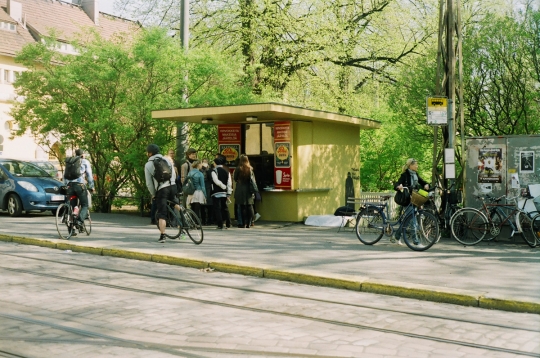
Snapshot from one of the restaurants open for the first Ravintolapäivä
In our booklet we're pulling together a bit of the history, current evidence, and indications of where there is untapped potential for innovation. Ultmately we are looking into the past before speculating about the next hundred years of everyday food in Helsinki and how we can make them even better. And in that regard we're focusing on how the dark matter, all the bits that situate food within our everyday lives—or not.
And to end, an observation about the color of milk packaging in northern Europe, provided by the ever amusing and insightful The Kaspar Stromman Design Blog.
First, a note from one of Sitra's other projects called Reviving Village Within A Town. In an effort to enable young people to have a more active role in co-designing the services that are available to them (like sports programmes), and therefore also getting more out of these services, we find two intertwined lessons. One about time and one about scale.
“People are active themselves instead of waiting for others to do things on their behalf. After all, local well-being is built on the people’s own initiative and activity,” [project manager] Mira Sillanpää points out. “You must also remember that it is not always about creating all-embracing solutions for the long term. Small changes can also have a huge impact. If the needs of the local residents change, the services provided by local authorities must change accordingly.”
In Mira's observations as quoted above, there are familiar tones of the ethos of prototyping, of beta, and of iteration. But perhaps more profound is what she gets to at the end: that times change, needs change, and that our public services should be similarly agile. In other words, being able to end programmes gracefully is as important as starting them intelligently.
And this ties to another aspect of the project which is embeded in the very name of the work: Reviving Village Within a Town. Lurking here is a recognition that scale matters too. The project is located in Hämeenlinna, a town that includes a number of smaller villages. By making room for local communities to conduct low-risk experiments in their own areas, we gain the ability to test and iterate at a more manageable scale before growing or replicating what works to other communities.
In other words, early innovations are not for everyone, and not for everywhere. Utilizing the small scale—in both time and space—allows us to be more sophisticated about our risk assessments. More of this please.
Twelve thousand kilometers away, in sunny Buenos Aires, the government there is also thinking about the power of the small scale, albeit in different ways. While in Argentina to give a talk as part of the CMD international design conference, I noticed that some of the parks have signs which implore residents to visit a Facebook page like this one. One finds a brief bit of history about the place, an invitation to share stories, participate in events, and to use the public space to organize your own functions. Smart, simple, cheap.
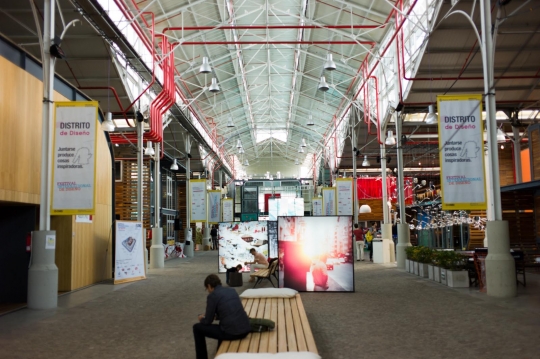
CMD is housed in a large building that used to be a fish market. It's vast!
But to CMD, the main point of the trip. The Centro Metropolitano de Diseño is a facility sponsored by the city government of Buenos Aires in an attempt to boost the creative industries. It's a bit similar to the the Design Forum here in Helsinki, except CMD also includes incubation space for young design-led companies. Under the ambitious leadership of Enrique Avogadro, CMD are expanding their focus to look at the potential for design-related business and programmes that are able to generate social capital in addition to financial capital. Being located next to one of Buenos Aires' villas provides extra imperative. This is the context in which I was there to share Sitra's work on strategic design, and particularly what it means to practice design in a public sector context.
Back here in Helsinki, as we continue to develop our work on the mysterious exchange project, we've been looking at things like this Bloomberg Innovation Delivery Fellowship. And then for no particular reason other than the fact that we saw it from a couple different people on twitter, also MIT's Atlas of Economic Complexity.
Dan spent a couple days in Sigtuna, Sweden where he was part of an international workshop hosted by MISTRA, The Foundation for Strategic Environmental Research, who are undertaking an ongoing indea development programme to identify new areas of research. After that he and I were consolidating thoughts on some small renovations to the Sitra tower.
Marco was in Finland but in and out of the office, including giving a talk at a Fortum event as well as taking part of the ongoing World Design Capital public sector working group.
Justin took a day trip from Boston down to New York to meet with the consulate there and begin preparations for an upcoming book launch later this month. He's also taking care of logistics for a launch in Boston, so if you're interested in either of these, check back in a week or so for further details.
And daylight savings time happened, so it's officially dark here. This was week 137.
Notes rather than thoughts/links this week, if you don't mind. First up, a few meetings.
Bryan and I caught up with Ville Relander, the City of Helsinki's PM for their Food Culture Strategy. Many, many ideas spinning out of that one, as food culture is one of the most exciting and rapidly moving development areas in Finland. Equally, food is a way in to so many everyday systems: local culture, logistics, entrepreneurship, national identity, immigration, sustainability, service culture, retail, smart systems, production, industry, popular culture, urban planning, health, education, waste, the relationship between urban and rural; it's all in there. It's a key area for us, in terms of systemic change. We look forward to working with Ville on this.
(Incidentally, we met at Kluuvi, the newly-opened complex in the city centre, which is worth a look. Not least the excellent Eat&Joy Maatilatori (farmers' market) in the basement.)
Sitra also hosted a visit from Fundación Chile, one of the few organisations with a similar remit and position to ours. As part of the visit, Bryan and I met with Francoise Tirreau Glasinovic and Alejandro Tocigl.
It happened to be a rather beautiful autumn day, so we took Francoise and Alejandro for a walk around the harbour from Ruoholahti to Moko on Perämiehenkatu. Although there are key differences, the similarities between our organisations are manyfold. We talked for a couple of hours and we were probably only just getting going. Key areas of interest included different tactics for overcoming the tendency of project teams towards silos, or conversely towards proliferation of project ideas, and how to measure multiple forms of 'capital' from investments and projects, such as those suggested by concepts such as shared value. And so in turn, how to decide what to do in the first place! Many thanks to Francoise and Alejandro for dropping by and for the great conversation—we will continue the dialogue.
The strategy and budgeting process rolls on, and fills many of the gaps left between these conversations. We're knee-deep in it, but the end of the beginning is in the sight. It was good to hear that we (Sitra) had a very well-attended external stakeholder day recently, providing strong input from outside. Bryan and I will be working with our colleague Tuula to ensure all these conversations turn into useful tools for the organisation.
In between all that, it was a week of engagement through events. Marco was in Taipei for much of the week, at the 2011 International Design Alliance Congress, presenting Low2No and taking part in a panel on urbanism. Justin was at DMI Design Management Annual 36: Design at Scale, in New York (and good to hear from Justin that old friends Jake Barton and Nicola Twilley were on top form.) Bryan took off for Buenos Aires for the Centro Metropolitano de Diseño for various events, including giving a talk at the Design Festival, and general scouting. I was holding the fort in Helsinki all week, but will report back on last week's Tallinn conference shortly, and prep for next week's trip to Sigtuna for a Mistra gathering.
I did however give a talk at Nokia on Friday, to their design team (Marko Ahtisaari invited us, after we attended Joi Ito's talk a few weeks back.) Interesting times at Nokia, given the announcement of their new phones the day before. It remains to be seen whether this is a comeback, but there are always some smart cookies there, and the Lumia/Asha/flexible concept phone combo has already changed the conversation around the company. Thanks to Matt George for hosting, and organising a good crowd.
While out and about, no doubt preparing for Snowtober, Justin also snapped this pic of In Studio in situ at MIT Press, in Cambridge Mass, which means of course that you can buy it there. As reported last week, it's getting out there. Do keep your feedback coming in—it's invaluable learning for us.
At DMI NYC, Justin had given a quick welcome/overview to DMI Helsinki in 2012. On related matters, congratulations to Cape Town, winner of World Design Capital 2014.
Helsinki is next year's WDC, and as with the Finnish winter, we are beginning to sense its imminent arrival. Preparations and planning are beginning to transform into activity, and it will be fascinating to see what it feels like on the street. I remember being impressed with how Victoria's State of Design festival was so vividly present in the city of Melbourne, rather more than Sydney's Design, say (no fault of the very capable Sydney Design organisers by the way; just some key differences in levels of funding and particularities of urban fabric and culture.) It wasn't so much painting the town red as turning the city over to design for a couple of weeks. It's a challenge to sustain that for an entire year, but the programme for Helsinki WDC look to be nicely diverse at this point.
More to follow on Sitra's involvement with WDC Helsinki.
And following last week's links to reports from inside Occupy New York, this from inside Occupy London, by Madeleine Bunting in today's Guardian. From "architecture of consciousness" to "key symbolic public space".
Logistics first: Justin and I were in the office all week; Dan spent half of it in Tallinn presenting at Creative Entrepreneurship for a Competitive Economy; and Marco was around until today, when he left for Tapiei to give a pair of talks at the IDA World Congress. This upcoming week Justin will be at the Design Management Institute event in New York and I will be at CMD in Buenos Aires to give a presentation there. We all have some copies of the book in our luggage, so say hi if you want one.
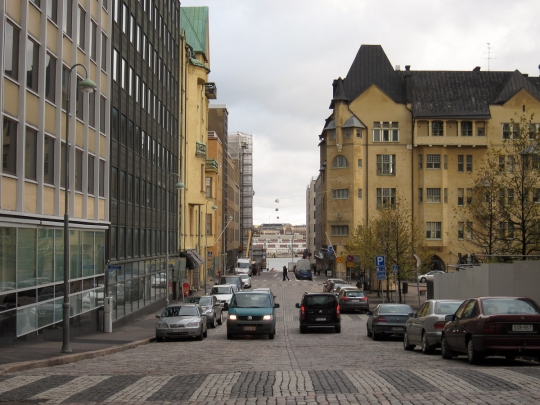
Fall in Helsinki's Kaartintori
Back at home, we enjoyed hosting Norway's Agency for Public Management and eGovernment (Difi) who came to visit on Thursday. Together with Sitra colleagues Sari, Ossi, and Marja we had a good conversation about the challenge of balancing the need to change public sector culture with the realities of having to do so in a non-disruptive way. This conversation echoed some of the things we discussed in our meeting with the UK Cabinet office mentioned here, as well as the general tone of MindLab's How Public Design? seminar in September.
Budgeting exercises continue, as does the ongoing process of shaping a portfolio of projects for 2012. More about this when we have something stable to share.
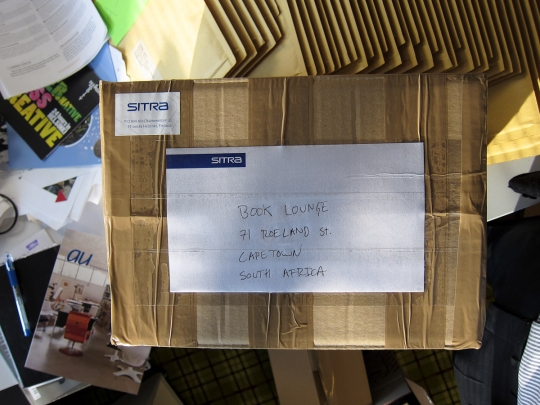
I had a fight with the label printer and it won
We're happy to announce that we've added two more bookshops to our fledgling distribution network for the book. Booklounge in Cape Town, South Africa and the SFMOMA Museum in San Francisco, USA will shortly have copies on sale.
Meanwhile, Marco has been steadfastly making his way through out mailing list, sending out copies to some of our stakeholders. His signature-singining fingers are getting a good workout.
Last week Dan entertained us with a quirky video from Finland's history, this week we go to Canada where they've created a creepy origin myth out of Marshall McLuhan's famous line "the medium is the message."
And then, perhaps, to New York, where the Occupy Wall Street protests have become a focal point for contemplating contemporary democracy. Lots of good writing on this, but I particularly enjoyed Michael Kimmelman's analysis in the New York Times:
It so happens that near the start of the protest, when the police banned megaphones at Zuccotti Park, they obliged demonstrators to come up with an alternative. “Mic checks” became the consensus method of circulating announcements, spread through the crowd by people repeating, phrase by phrase, what a speaker had said to others around them, compelling everyone, as it were, to speak in one voice. It’s like the old game of telephone, and it is painstakingly slow.
“But so is democracy,” as Jay Gaussoin, a 46-year-old unemployed actor and carpenter, put it to me. “We’re so distracted these days, people have forgotten how to focus. But the ‘mic check’ demands not just that we listen to other people’s opinions but that we really hear what they’re saying because we have to repeat their words exactly.
“It requires an architecture of consciousness,” was Mr. Gaussoin’s apt phrase.
Recently I happened to spot a micro-protest in a different medium in the subway tubes of Helsinki. Someone has posted EI KIITOS ("no thanks") stickers on most of the advertisements. I like that in both examples there's a politeness to the protest, even if a bit facetious. OWS is by far the more interesting of the two because of the infrastructure that the community has had to build now.
While they are definitely saying no to something, they protestors are also obliged to prototype a constructive example of how to organize human society. And not just the mic checks described above, but an entire miniture society including its own food service, sanitation department, library, and more.
Like any society, that one that has bootstrapped itself in Zuccotti Park has its own issues. Chris Cobb describes in Domus the group's creation of special women-only sleeping areas, for instance, which seems to imply that it's no oasis.
Lately I've been reading a lot of materials from open source movements and feeling as though we're living through a moment similar to the birth of the hippies in the 1960s, and the specific of the OWS story underline this thought. It also strikes me as a particularly American form of protest: complain, sure, but mostly just build the thing you want somewhere else. When you're condemming the global financial system, however, I'm not sure there is a somewhere else. And that's the problem.
Regardless of how the occupation plays out, I hope that one of the more lasting outcomes is an enhanced recognition of the need to develop a new culture of decision making. There are issues when the decisions of 1% outweigh the other 99, as there are when one form of value, such as finacial gain, dominate all others, like environmental and social returns.
A new culture is already emerging as public outrage, social media, and generally high levels of complexity begin to intersect. The real question is whether our formal democratic forums—our parliaments—will be able to handle it in a constructive way. Or if they end up in fisticuffs.
Note: We've had a bit of a technical problem with this post so it disappeared for a better part of Sunday. Sorry about that!
A mixed bag of links, reports and observations this week.
Although it's just been found to be in fine fettle in terms of its core missions (link; Finnish) Sitra is looking at its new strategy for the next few years. We're all getting heavily involved in that process—as the Strategic Design Unit, we sit in Sitra's internal strategy function, headed by Paula Laine.
We're also heavily involved in reviewing the design documentation for one of our core projects, Low2No. Justin is stewarding that complex process through, which is not easy given the complexity of the project and the number of stakeholders involved. Note also Justin's writing about some early indications of potential systemic change emanating from Low2No, in terms of other timber construction projects beginning to spring up in Finland.
Bryan was in Romania for a seminar and workshop - he'll post separately about that in a day or so. Marco has been buzzing around the city, meeting potential partners across various projects. Some exciting developments there, potentially around the aforementioned and still mysterious Exchange project.
I've been working more on the Street Food briefing—including spending an early Saturday morning tramping around Helsinki's streets filming somewhat disgusting discarded detritus from Friday's night's various grilli nightclub collisions. More to follow on that. The footage should balance my recent ode to Helsinki, that's for sure.
Earlier in the week, Bryan and I had a great meeting with Steve Lawrence, Executive Officer of the Australian Social Innovation Exchange (ASIX) who was passing through town. Despite our different backgrounds, we had lots of shared vocabulary, interests and approaches, which was very heartening. Steve had also carefully read In Studio, and had a series of dauntingly perceptive questions for is. It made for a rewarding lunch; thanks to Steve for popping by. Which reminds me, if you're ever in our neck of the woods, do get in touch - we're always interested in people doing similar work.
Finnish education made headlines in the US last week, some of it here in the Washington Post and some of it here on CNN.
It's a real success story for the country (not least for this dad with two children in the Finnish system!) but one which was also the focus of one our studios last year. Bryan and I in particular are spending a fair amount of time discussing the so-called 'Nordic Model' (see Mary Hilson's book, which I'm reading) and how these broad 'spirit level' systems (see also healthcare, and many other aspects of Finnish daily life) can continue to develop and progress, drawing in external sparks of innovation and accessing new funding models without losing their incredible ability to provide high quality service provision right across the population.
On a personal note, my wife and I had a parent-teacher meeting at our kids' päiväkoti (daycare) recently, which was a) as close to group therapy as I'm ever likely to get (in a good way), and b) utterly instructive and encouraging about the teachers' careful, considered but ultimately warmly human-centred interest in kids exploring their emotional range, their natural environment, their physicality, their social ecosystems, and so on, with barely a direct mention of literacy and numeracy. That comes later, as the PISA results indicate.
Switching gears, it's been extraordinarily thought-provoking to see the Occupy protests spread around the world this week. One of our core concerns is the apparently increasing lack of faith in governments' ability to deliver solutions to today's complex problems (and this despite Silvio gettting a vote of confidence).
That's partly what seems to be playing out here in the Occupy movement, but was also present in the riots in the UK earlier this year, in various aspects of the Arab Spring, and in protests on the streets of Athens, as ell as in numerous other less visible arena. We're interested in understanding the various cultures of decision-making at play at the moment, and in recent history, and in deploying projects which begin to explore various alternative trajectories for governance, at all levels. Anyone interested in this work, or with something to say, please drop us a line.
In terms of toolkits rather than attitudes, visualisation is another of our core interests, so it was also interesting to read another article in The Guardian (NB: other news sources are available), concerning the quality and range of data visualisation on offer, in the light of recent critiques. Personally, I'd agree that many examples of information and/or data visualisation are indeed the mullets of the internet. Yet a good visualisation can engage, focus and stimulate dialogue like few other media. Embedded in that Guardian article, check the (WWF-style-not-really) face-off between David McCandless and the legendary Neville Brody.
As Bryan mentioned last week, our work featured in The Guardian. It's been interesting to observe the reaction to that—largely positive, for which thanks—and how it grew and diversified over the week. One aspect of that discussion within the design discipline concerned picking apart the difference between strategic design, design thinking and service design. To me, these are all quite clearly different aspects of design, albeit with occasional overlaps. To other people? Not so much!
As it happens, I'm writing something that will try to pick that apart a little, at least at an initial level. I'm pottering away at this in the mornings before work (whatever "before work" means), usually at the excellent Gran Delicato café. The text should be out later in the year, all being well. Will keep you posted.
In terms of other ripples from the article, see also this Spanish translation of the piece. We're thinking of making 'La crisis es el momento de que entre en juego el diseño' t-shirts accordingly.
And finally, some links.
A favourite landmark here in Helsinki is the Hotel Torni, a sort of mini-me Empire State from 1928, which is crowned by a fabulous viewing deck. Legend has it that this was designed for mooring airships to, such that airborne visitors from Paris or Berlin, say, could elegantly descend from the airship (somehow?) directly to the bar for a civilised long drink during the white nights. This image is rarely from our minds, for I hope obvious reasons, along with the notion that surely it's time for the return of dirigibles to our skies as passenger aircraft. As a result we found ourself gazing longingly at these wonderful vintage images of the USS Akron and Macon. Unlike the airships intended for Hotel Torni's mast, Akron and Macon were airborne aircraft carriers, from which aeroplanes would enter and exit through a 'plane-shaped opening in the ship's skin (reminiscent of Wile E. Coyote-shaped holes in various other objects). This, they would do via a trapeze. Yes really.
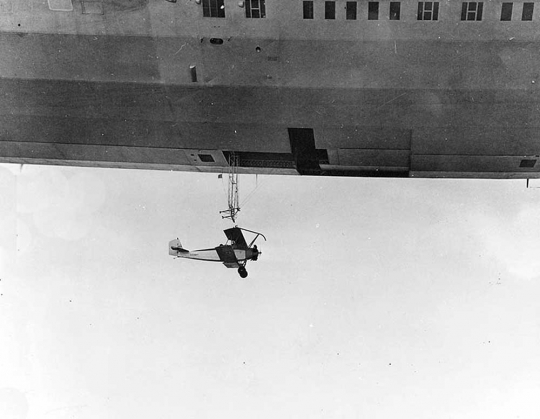
Training plane on USS Akron trapeze

Main ring design: Hindenburg vs. USS Akron
And I cannot get this data-point out of my head: apparently, during the recent Blackberry outage, traffic accidents in Abu Dhabi dropped by 40%. Oh humanity! A distressing, almost visceral illustration of the interconnectedness of systems across boundaries.
Humanity is partially redeemed by this exploration of abstraction by Bret Victor, however, which has beguiled a few of us all week.
Finally, if you've ever wondered how we open doors here in Finland, it's like this. Or at least it was in 1979. (Press the CC button at the bottom of the video for subtitles, if your Finnish isn't up to scratch.) Do not be a bad door opener.
It's happening again. The timeline between the end of week and our weeknote going live is slipping. This is mostly due to the fact that we're at a wonderful moment in the year: budgeting. At Sitra we're crossing our tees and dotting our eyes on the plans for next year, playing out scenarios at different investment levels, and having a conversation about how to best manage the portfolio of projects.
In light of the above-mentioned focus soaking up a lot of our attention, a random sampling of Things We Looked At.

Still from Social Life of Small Urban Places, a film by William H. Whyte. More on this below...
Today we're flattered to see our efforts highlighted in a piece in today's edition of the UK's Guardian. The essay by Justin McGuirk does a great job of explaining how we approach situations which are often difficult to make sense of, let alone gain traction on. Justin's explanation of the way that specific, tangible entry points allows for new forms of consensus is a refreshing read. We are often struggling to put these notions into clear words, so it's nice when someone else does your job for you.
A trickle of feedback is coming in from the book. Thank you to everyone who has taken the time to share your thoughts with us already. We've taken to saving these emails to a folder and in some cases printing them out and dropping them in the impact box, a tattered cardboard container filled with tokens that help us trace the impact of our work.
It feels a bit funny to revert to such a low tech solution, but the palpable sense of accumulation is a nice psychological side effect. One of the things we're trying to be better about is understanding the feedback and responding to it as we shape future plans. So by all means, if you're keen to give us feedback on how you see HDL as useful to your work, or how it might be more useful, we're all ears.
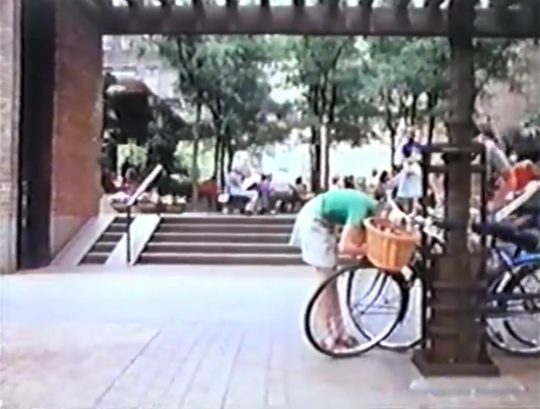
Another still from Social Life of Small Urban Places, a film by William H. Whyte
Speaking of books, I will be in Romania this week delivering a keynote and a workshop at the Connection 2011 conference. I'll have a couple copies of the book with me so if you're interested in having one, just ask.
Film break! Careful... you're in for a full hour.
How excellent is that? Dan and I have been digging through some archival materials (including the Social Life of Small Urban Spaces) as we explore the notion of "legible practice." What does it mean to carry out a body of work and to self-consciously do so in a way that makes it easier for others to follow or to join in?
In some sense this has been a discourse about what it means to be "open" but we've gravitated more towards the word "legible" because it speaks to the difference between just doing something where people can observe, and doing in a way that opens up and documents the tacit decisions for others to understand.
William Whyte's work checks the usual boxes of sitting at the intersection of design and social sciences, but what inspires us is the blunt, thorough approach to observation as an evidence base for design principles. The video is still refreshing from the vantage point of these 23 years on. It's this kind of spirit that we are subtlely trying to bring to our work (and yours?) through tools like the Design Ethnography fieldguide.
If you're into this kind of design practice, I highly recommend that you take a look at the Young Foundation's Head of Design job posting. It's a good post at a great outfit but applications close this week.
Finally, I'm happy to have the opportunity to point to work by Seungho Lee, our superstar intern from last year, who is doing great stuff through the venue of his company About:Blank which makes excellent products with local craftspeople here in Finland. This video is about one of About:Blank's chairs, a humble process that nevertheless is pursued with an excruciating level of detail and care. Congratulations to Seungho & team.
One more thing. It's fall time here and the many courtyards of Helsinki are, for these few weeks, some of the best kept secrets of Europe.
The air is increasingly crisp as autumn falls upon Helsinki. And yet summer is not giving up without a fight. This week we enjoyed one of the warmest September days on record. It does feel warmer than last year about this time.
We have been taking advantage of the weather by getting in a few last exploratory walks for lunch or mid-day coffee. As winter sets in the radius of lunchtime possibility closes down and the daily rituals change. We try to take as much advantage of the warm months as possible, often working in cafes, libraries, or other nooks around the city for half the day or so. As it cools off we'll be spending more time in the mothership.
Beyond the niceties of a good lunch, food has been a focus lately because of a bit of work we're doing. Street food, in particular, though we're taking a rather wide interpretation of the term. More on this soon, as we are preparing a slim publication on the topic. But the gist is that we're interested in how food cuts right to the nexus of so many interlocking systems. While it is deeply cultural, ephemeral, and literally a mater of taste, food is also an essential current in the hard flows of economics, health, and logistics.
As we pursue ways to positively affect the systems that shape daily life, we are searcing for entry points. The essentialness of food makes it a great candidate to act as a tangible pivot or hinge which allows us to research, observe, and design simultaneously at a very minute level where execution is direct and feedback loops are quick, as well as more abstract and systemic levels which on their own lack immediate feedback. More on this as it develops.
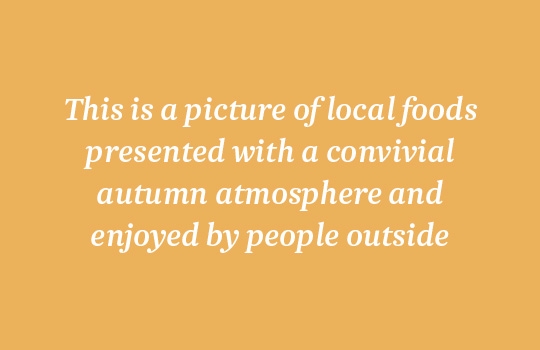
And it used to be a real picture of the Fiskars Slow Food festival held this weekend. That was until my camera decided to reformat its memory card.
University of Helsinki have recently published a video. It features a herring and it is a nice video.
From food to space. The other topic on high rotation within the team is community decision making. How do we make decisions together? And more specifically, how do we make decisions when it's not possible to agree to disagree, such as when there's a chunk of the city involved. A park, a disused lot, a nice corner, a store front. That kind of thing.
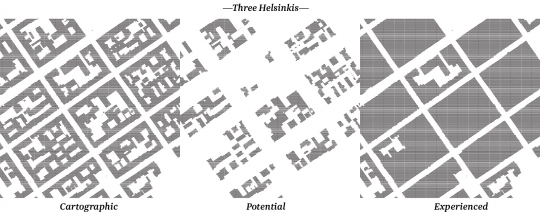
Borrowing from Nolli and thinking about more rigorously pursuing his technique of mapping the public realm.
Although this is a very nascent topic for us as yet, we've been doing some sketching. This one in particular is a quick study of the 'hidden' courtyards of Helsinki. Although the city is full of wonderful interior courtyards, they're mostly out of sight and really quite out of mind. How could these spaces become more of an asset to the city?
Both of these projects are orbiting around ideas that we explored with Clues to Open Hesinki, a pack of 'postcards from the future' that we created with the help of OK Do last spring. And while both the food and the courtyards have come back onto the radar through their own paths, it is interesting to reflect on the fact that they were also amongst the dominant themes of the conversations we had when developing Clues. I suppose I should say that it's gratifying, actually. The small bet we made with that project is now repaying its dividends and proving to be useful preliminary research for two projects which have their own focus at a new scale of ambition.
A small note about the book: I've updated the page to include information about where to find it in book stores. Currently there are only two, but I'm hoping to have time to work on expanding this list a bit. If you have suggestions for appropriate shops in your neck of the woods please leave a comment here.
Other projects: Justin continues to tweak the Low2No website, which is overflowing with details about the project; Marco had some promising meetings relating to the exchange, as well as work related to World Design Capital; Dan has been wrapping up some essential elements of groundwork for the smart systems aspects of Low2No as well as writing about food; I was out half the week on a mini-break and then handling the technical bits of the Low2No site; and Johanna is handling logistics and administration steady as ever.
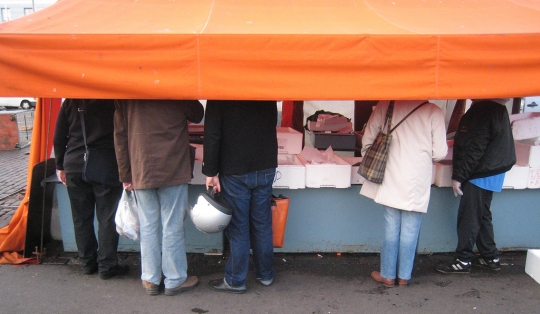
Justin enjoyed the Herring Fair three years ago.
To close this weeknote I'll leave you with a link to MindLab's wrap up summary of their How Public Design? event that Marco and I enjoyed last month. Have a look—we'll be doing the same, perhaps after a visit to the Helsinki Baltic Herring Fair.
This week's diaries look much the same as last week's. Another launch event for the HDL In Studio book, but this time in London.
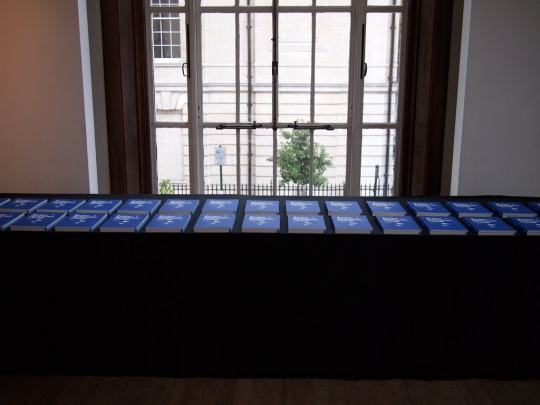
HDL In Studio books waiting to be launched.
Before the launch though, Bryan, Marco and I take part in a roundtable on 'getting systemic change done'. We'd jointly organised the event with E3G, who hosted it at their Southwark HQ. We actually started on Monday night, pulling most of the participants together for dinner. (We often like to use this tactic of the-dinner-the-night-before; it breaks the ice in a natural, convivial way rather than through some dreadful exercise in which people are forced to suggest what kind of animal they would be if indeed they were an animal. It also enables people to tentatively pitch a starting position and rehearse some of the conversation. And it means you can hit the ground running in the morning. Plus, it's dinner.)
And Tuesday was excellent. Participants included Alejandro Litovsky from Earth Security Initiative, Sam Bickesteth from Climate and Development Knowledge Network, Kipper Blakely from Social Investors, 00/The Hub's Indy Johar, E3G's Nick Mabey, Malini Mehra from Centre for Social Markets, Peter Sharratt from Deloitte, and Dimitri Zhengelis from Cisco/LSE Cities. It was a long but fruitful day, with the morning spent presenting and comparing case studies, and the afternoon spent poring over the common ground.
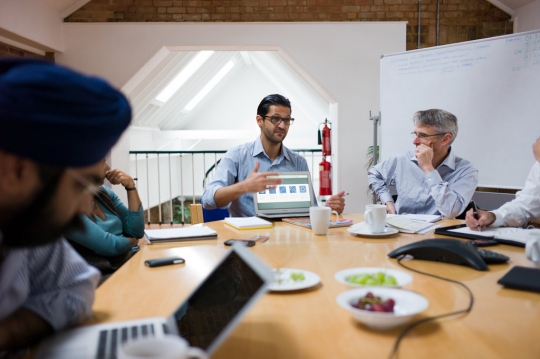
We banned Powerpoint for this session, but made a small exception for Alejandro's diagram.
With much of the group talking about inspirational change projects around climate change, sustainability and government, often from the context of exerting change from 'outside' a system, I decided to present a contrast, talking about my work at the BBC, around the iPlayer on-demand media service. This was a form of design work conducted from deep inside an organisation; sometimes instinctive, sometimes tactical, sometimes strategic.
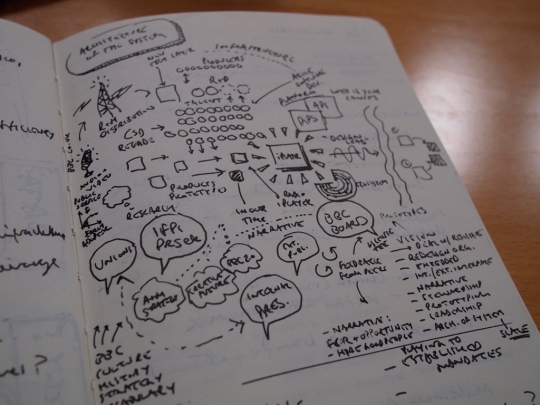
Notebook sketch of iPlayer 'architecture of the problem'.
This preparatory sketch from my notebook, scribbled over breakfast, really represents the tip of the iceberg in terms of design of both context and product. I transferred the diagram to the whiteboard as I told the story, in order to give a sense of how messy, complex and multi-dimensional this embedded design work can be. I never thought of it as "strategic design" at the time, and indeed though it's quite different to much of the work now, there are many shared elements—not least as these services do represent a form of systemic change, albeit with different purpose.
Ultimately, this was a demonstration of understanding 'the architecture of the problem', as we would now call it, or how contemporary media works as a system (see some earlier thinking about how contemporary media works) and how that connects to organisations and culture. This was beyond editorial concerns; that the design of media systems and organisations themselves was the strategic act that would alter the greater system.
Indeed, though it was a deliberate choice as contrast, what was interesting in the morning's discussion was seeing how much commonality there was between case studies and discussions. The others round the table presented some fascinating projects, ranging from the UK's Green Infrastructure Bank to The Hub project, via case studies from South Africa, India, Thailand, UAE, Argentina and of course Finland.
Much to chew on, and we're looking to develop that and other discussions over the next few months. As this territory is yet to be coherently mapped, we draw a lot from these conversations.
We launched the HDL In Studio book at the Royal Institute of British Architects (RIBA) on Wednesday morning. We had a good gathering for coffee and korvapuusti (Finnish cinamon buns, sourced from the Nordic Bakery in Marylebone via Bryan!).
Marco gave an introduction and hosted a discussion with Peter Sharratt, an architect and sustainable development leader now working at Deloitte, and Marianne Guldbransen, Head of Design Strategy at the UK's Design Council.
Our books disappeared faster than the korvapuusti, which is surely a good sign.
As a self-indulgent sidenote, it was a particular pleasure to be back at RIBA. When I was at the BBC, based at Broadcasting House down the road, we would often use the place for awaydays and meetings of all kinds; plus, it was a favourite 'hiding place' from my team when I needed to get some concentrated work done. (Sorry team.) It's a wonderful space.
After the launch, we hot-foot it across town to Whitehall, accompanied by NESTA's Laura Bunt, to visit the UK government, with whom we swapped notes in another fascinating, thought-provoking session. This was followed by lunch and more productive note-swapping (a theme of the week) at the Institute for Government in Carlton Gardens.
The rest of the week was spent back in Helsinki, keeping various projects ticking over. I gave a talk at Fjord Helsinki on Friday morning (thanks for the invite, Fjord!) on various aspects of our work. It was good to see their team, and their space. Their regular Friday morning shared-breakfast-at-long-table-plus-talk will be something I'll take into our conversations at Sitra, concerning our future workspace.
I also met a local researcher (via Demos Helsinki—ta!) who we'll ask to unpack some food supply chains for us. I've been working on a briefing document around food culture in Finland, and a diagram laying out just how, say, a hot dog emerges on a Helsinki street corner late one night will probably be particularly interesting.
Justin and Bryan have been knee-deep in re-launching the Low2No website (Low2No is one of our key 'systemic change' projects, predicated on building a new neighbourhood in Helsinki.) Do take a look and have a poke around; there's lots of new material and a sharper design to help you find it (which will be familiar to users of this site.) We're starting to carefully pick apart the difference between the block and the model (watch for some forthcoming writing on this 'hook/trojan horse' approach) as well as some curated contributions unpacking the idea of sustainable cities in general.
For instance, read the essay by Federico Parolotto and Francesca Arcuri of Mobility in Chain on sustainable mobility. I had the pleasure of working with Federico in last year's 'zero-carbon Finland' HDL studio, and it's always interesting to hear Mobility In Chain's thoughts on these issues.
Finally, Marco has been hard at work setting up our third major project area, alongside HDL and L2N. Known internally as 'Exchange' at the moment, we'll reveal more of this as it emerges, but suffice to say it should test a new and important angle for our work. Pretty exciting if it comes off. More later.
When the calendar looks like this you know it's going to be a steamroller of a week.
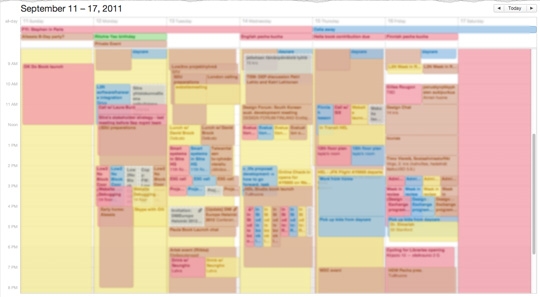
Names blurred to protect the innocent
The easiest place to begin is with the book that we mentioned last time. One week on from launch and we've had a modest bit of attention on that. So far a lot of encouraging feedback, so we are happy to hear that it is finding its way usefully into peoples' lives.
On Wednesday we held a launch event here in Helsinki to discuss some of the broader innovation challenges that the Studio Model was designed to tackle. And of course to give away copies of the book. We were humbled by the fact that About 60 people showed up on a rainy and blustery afternoon. Kiitos, kaikki!
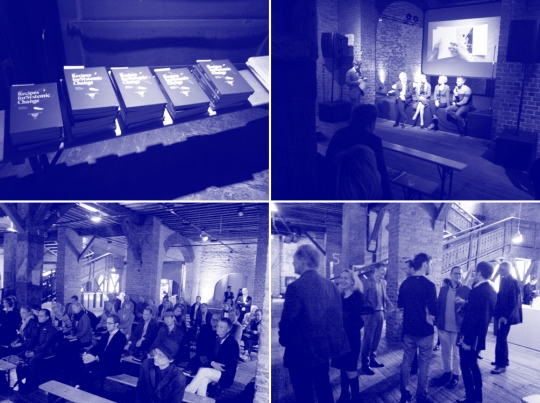
Colors changed to hide the fact that these were low resolution pics taken on a camera phone
On that note, if you're in London we will be in town this week for some meetings and are taking advantage of the opportunity to have a book launch there as well. See the Facebook page for details and please RSVP (soon!) if you would like to come.
As I was cleaning my desk I came across some sketches done in preparation for the book trailer video. We stayed pretty true to these thumbnails. Not bad for ideas drawn on a sick bag.
Enough with this book thing. Things continue apace on other endeavors. This includes work in-house that Dan and I are doing with our colleagues Olli and Tapio to prototype some of the working environments and habits we anticipate fostering in the eventual new offices which are part of Low2No. More on this soon.
It also means Justin, and to a lesser extent myself, spending late nights working on the new Low2No website which we will be soft launching soon. It should look familiar to readers of this blog.
Because three's a charm, another piece of great news came in for Low2No this week. The project has received an Acknowledgement Prize from the Holcim Foundation. Thanks to our partners at Arup, Sauerbruch Hutton, and Experientia are due as well for this.
Thursday morning while Marco was in Estonia presenting at the Nordic Council of Minister's Modern Eco-Cities conference, the rest of the team had breakfast with Joi Ito and Markko Ahtisaari.
Markko kindly invited us along to hear Joi give a talk at Nokia. Joi deftly connected many dots and it was a true pleasure to hear him talk about his plans for the MIT Media Lab, which he now directs. I'll keep this brief because the thoughts deserve a more careful bit of writing, but if there's one thing I took away from Joi's presentation it was this:
Because of the declining cost of doing things and increasing levels of complexity in the systems around us, it's often cheaper to prototype (and recover from potential failures) than it is to assess risk.
Update: Joi has posted about this on his website.
This dovetails nicely with some slow burn research we've been doing into what you might call 'cultures of decsion making.' Ultimately the ways in which we perceive, assess, and mitigate risk shape so much of what we allow ourselves to do. Likewise, the manner in which we anticipate, plan for, and recover from failure defines the outer limits of what we allow ourselves to reach for.
When we look at the rise of the open source software movement, agile project management, and the popularity of design these things add up to a new culture of decision making. The better we can coherently articulate the value of these approaches as ways to cope with the GFC and other black swans, the more likely we are to find a way through.
Or at least that's the hypothesis we're prototyping.
Perhaps the last thing we expected to do Thursday was end the day by moving 742 kilograms of paper, cardboard, and ink around Sitra HQ. But when a shipment arrives and the palette it sits on does not fit into the elevator, this is what happens. In other words, the book that we've been mentioning on this blog is finally here! Thanks to the helping hands of Seppo, who makes this building tick through his steady management of the front desk, we were able to get everything in from the loading dock in no time.
Inside were lots of these:
In Studio: Recipes for Systemic Change is a book about crafting vision. It's about how to take something big, messy, and complex and very rapidly begin developing a way to respond to the problem. It gives an introduction to the what and why of strategic design, documents the studios that we hosted last year, and then offers a practical "how-to" manual for hosting your own studio. Hop over to the book page and watch the trailer video.
Marco, Justin, and I are really honored to have a Foreword from Geoff Mulgan of NESTA and an Afterword by our very own Mikko Kosonen. These contributions put the work of Sitra's strategic design unit into the wider context of Sitra's activities as a whole, as well as the social innovation more broadly.
We have some launch events coming up and are looking forward to these as opportunities to meet old friends and hopefully also some new ones. If you've been following the blog or interested in Sitra's strategic design work it would be great to meet you. Please join us for one of the events in Helsinki or London.
Putting the book together has been an excellent—if sometimes grueling—opportunity to revisit the ways that we talk about our work. But it's also amazing the number of decisions put into motion by something seemingly as simple as "let's write a book". What began with documenting our work in a format that is easy to share, grew into a mess of micro projects that looks something like this:
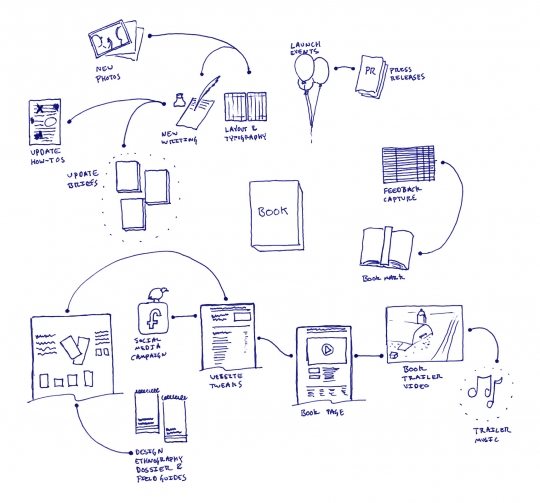
Sometimes a simple book is not so simple.
TwoPoints have done a stellar job with the physical object; we've tried our best to create a PDF that is as easy as possible to use (for instance, it has a hyperlinked table of contents); and Sitra Communications team have been doing bang-up job helping with the press stuff. Well done, everyone.
More pictures. Or in other words, this is where we fulfill Justin's dream of being a hand model.
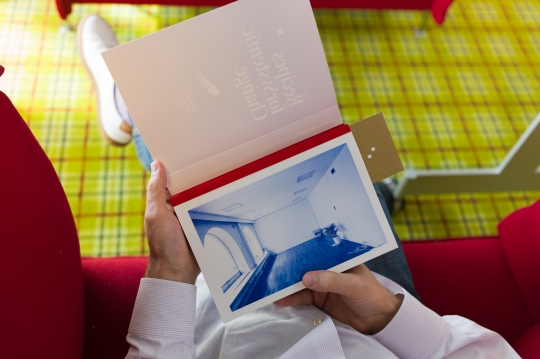
There's a cloth binding hiding inside.

All three Challenge Briefings from last year's studios have been refined and included here.

The bookmark is a thinly veiled attempt to solicit feedback.
To highlight some of the ancillary things we've been lining up before the book launch, there's a new dossier on design ethnography. This includes a "fieldguide" available in English and Finnish. It comes out of the Synergize Finland studios that we hosted earlier this year. We've also been adjusting this website to link up with Facebook, for instance, and to be more suitable for reading on an iPad and other tablet devices.
Onwards, onwards. If you're here in Helsinki enjoy Design Week and perhaps we'll see you around town.
